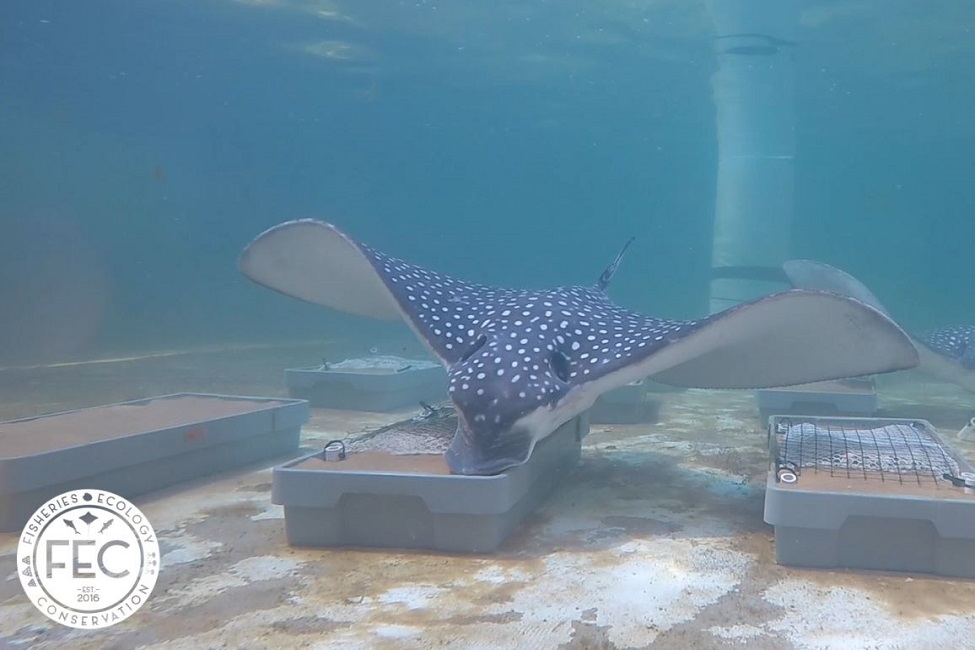Does Current Shellfish Culture Gear Curb ‘Crunching’ Rays?

A whitespotted eagle ray “crunching” on clams in a large outdoor tank with clams housed within a variety of anti-predator materials.
According to NOAA Fisheries, more than 80 percent of marine aquaculture production in the United States consists of bivalve mollusks such as oysters, clams and mussels. However, it’s not just humans who enjoy eating these shellfish, so do marine rays. They like to “crunch” on clams, which can sometimes take a big bite out of clammers’ profits.
Part of the process of culturing hard clams (Mercenaria mercenaria) involves deploying them in submerged bottom leases in the marine environment where clams can grow to market size. When deployed onto the clam lease, clammers incorporate a variety of anti-predator materials to protect their product, such as woven mesh netting and/or additional mesh, plastic or wire covers.
However, the effectiveness of these materials against highly mobile predators like rays has not been experimentally tested. Some rays, like the whitespotted eagle ray (Aetobatus narinari), are equipped with strong jaws, plate-like teeth and nimble pectoral fins, which make them formidable and highly maneuverable predators of clams.
Inspired by clammer reports of damaged grow-out gear presumably caused by rays, researchers from Florida Atlantic University’s Harbor Branch Oceanographic Institute in collaboration with Mote Marine Laboratory, assessed the ability of the whitespotted eagle ray to interact with clams housed within a variety anti-predator materials.
Using aerial and underwater videos, researchers assessed the rays’ responses to anti-predator materials placed within a large outdoor tank. They examined their interactions with a control plot (unprotected clams), clams inside polyester mesh clam bags (dipped in a latex net coating), and with clams under high density polyethylene (HDPE) netting or chicken wire cover netting. After the completion of each trial, researchers assessed the number of crunched clams and frequency of visits to the various randomized patches.
Results, published in the journal Aquaculture Environment Interactions , showed that rays were capable of consuming clams through bags. However, anti-predator treatments reduced clam mortality four- to tenfold compared to control plots. Double-layered (bags with cover netting) treatments had the lowest clam mortality, highlighting the utility of this type of protection in limiting ray impacts.
“Based on our findings, many of the current anti-predator grow-out strategies used in the hard clam shellfish aquaculture industry appear capable of reducing predation by large predators like whitespotted eagle rays,” said Matt Ajemian, Ph.D., senior author, an associate research professor and director of the Fisheries Ecology and Conservation Lab at FAU Harbor Branch. “In particular, bag treatments with cover nettings achieved the highest clam survival rates, although it is important to note that this did not appear to completely deter rays from interacting with the gear.”
Observations from the study suggest that rays appear capable of interacting with aquaculture gear for prolonged periods, potentially diverting them from other natural feeding habitats such as sand and mud flats.
These habitat associations could expose these sensitive animals to other risks, although we are just beginning to understand them and admittedly have a lot more to learn,” said Brianna Cahill, corresponding author, an FAU Harbor Branch marine science and oceanography graduate, and a research technician at Stony Brook University.
Throughout the course of the study, researchers confirmed that rays are capable of uprooting and manipulating hard clam aquaculture gear, as they moved treatments and trays within the tank throughout the course of the experiments.
“Contrary to what we expected, rays did not prefer control plots (mimicking natural conditions) over treatment plots with anti-predator gear,” said Cahill. “This suggests a real possibility that these rays are interacting with shellfish aquaculture gear in the wild, as suggested by our clamming industry partners.”
Among the variety of interactions researchers observed between rays and the treatments included using their lower dental plate to dig through sediment to access clams in the control plots and to move the gear (clam bags, cover netting and trays). In addition, because HDPE netting appeared to snag on the rays’ lower dental plate, it caused them to displace the HDPE cover netting more than chicken wire cover netting.
Chicken wire has been used in Florida to deter predation from rays because of its strength. Research has suggested that the electric field of the metal can be detected by elasmobranchs such as rays and sharks, potentially acting as an over-stimulant and thus, a deterrent.
“Given the frequency of interactions we observed with chicken wire in our experiment, we question whether chicken wire is a deterrent, an attractant or neutral, as it may not have a powerful enough signal to influence the rays,” said Ajemian. “Still, we have more questions than we started with, and look forward to investigating this further with other species and deterrent types.”
Study co-authors are Kayla L. McCulloch, Rosenstiel School of Marine and Atmospheric Science, University of Miami; Breanna C. DeGroot, research coordinator, Fisheries Ecology and Conservation Lab at FAU Harbor Branch; and Kim Bassos-Hull, senior biologist at Mote Marine Laboratory.
Funding for these experiments was provided by the Aquaculture Specialty License Plate Fund (AWD-002112) administered by the Harbor Branch Oceanographic Institute Foundation.
-FAU-
Tags: research | harbor branch | faculty and staff | science